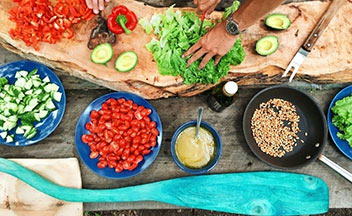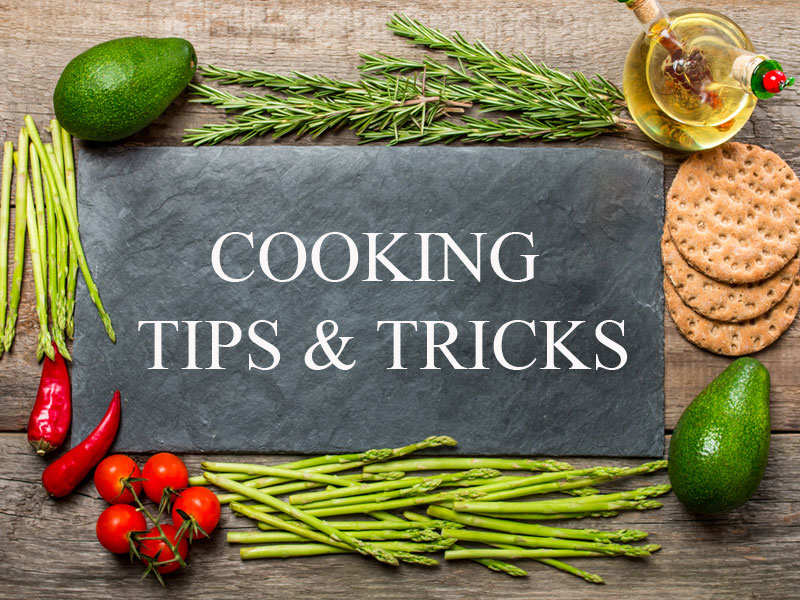
Healthy cooking isn't just a trend. Learn how to make your own stocks and broths so you can control the sodium and fat that goes into your food. When possible, use local ingredients. And, take an internal temperature reading of your food to ensure it's done. You won't regret doing it. Here are some other tips to get you started. You'll be surprised at just how easy it is to make healthier meals at home.
Healthy cooking is not a trend
Healthy cooking is a great way to improve your quality of life and your health. Healthy cooking isn’t a fad. Food companies, from Campbell Soup to PepsiCo, aren't just following a trend. They are actively making healthier food choices, and expanding their retail distribution.
Making your own stocks or broths gives you ultimate control over the amount of sodium and fat going into your meals
It can be delicious and healthy to make your own broths or stocks. The finished product can have a rich, earthy flavor thanks to bones. Bones can also be roasted to caramelize meat. The cartilage and gelatin from the veal bones add collagen and gelatin to the final stock. Stock can also be used to substitute for vegetable stock in many recipes if you are vegetarian. Bone broth is versatile and can be frozen for use at a later time.
One of the most versatile cooking liquids is vegetable stock. Mix vegetables, onions, and potatoes with sweetener/thickening agents. It works well for thick stews, gravies, sauces, and Swedish meatballs. Turkey stock, on the other hand, uses vegetables and spices. It's also an excellent way to use leftover pot pie. Don't worry if you don’t like chicken stock or beef. There are many options available for turkey and chicken stock.

It is best to take the temperature of the food before you eat it.
A food thermometer is a valuable tool when you are cooking poultry or meat. While the outside may look cooked, it isn't always. It is possible that your meat may not be fully cooked, as the juices of the meat or poultry might appear clear. This is a common mistake, but it doesn't necessarily indicate doneness.
To kill harmful bacteria and fungi, it is important to cook food at the correct temperature. Food poisoning is possible if it isn't heated to the right temperature. As a general rule, the food's internal temperature should be high enough to allow steam to escape. To test this, insert a thin knife through the meat/poultry's middle.
Using local ingredients
Locally-sourced ingredients can be a great way for restaurant owners to get more customers. While there's a risk of overcharging customers for local ingredients, using seasonal ingredients is a surefire way to keep costs down. You can also use USDA’s Mixing Bowl for recipes that are based only on what is readily available. Making seasonal menus is possible by using seasonal ingredients.
Locally-sourced ingredients offer many benefits, including the freshness and quality of the food. Local farmers will provide fresher and healthier meat and produce than the ones you would get from a supermarket. It's possible to support your local economy by working directly alongside local farmers instead of relying on large corporations. Choosing locally sourced produce and meats will help reduce your carbon footprint and support local businesses.

FAQ
Where can I find online cooking classes for free?
Many websites offer free cooking classes. YouTube has many videos that will show you how to cook different dishes. Some sites offer thousands of recipe options. The sites typically charge a monthly fee but you can test them for free for a period of 30 days.
Do I have to go to culinary school in order to be a professional chef?
No. Many chefs started their careers by learning on their own. Some even went on to culinary school to gain work experience. Culinary school is preferred by most chefs because they have more opportunities to grow and learn. Culinary schools offer hands-on training which allows students to improve their skills and knowledge of cooking.
What is the best way to store leftovers?
Tupperware containers are great for storing leftovers. These containers keep foods fresh and prevent odors from forming. These containers keep food warm for longer periods of time. You can freeze leftover food in freezer bags. To prevent air from escaping, freeze food in a bag. Once the food has been frozen, transfer it into an airtight container such as a zip lock bag.
What are the basic skills of cooking?
Basic cooking skills include being able to read and measure ingredients, prepare food safely, clean up after yourself, and cook. You need to master these skills if you want to cook for your own meals. You can also save money by cooking at home.
Statistics
- According to the BLS, chefs earn $58,740 a year. (learnhowtobecome.org)
- You'll be amazed that over 90% of CIA students receive scholarships and grants to finish their culinary studies. (ischoolconnect.com)
- under 10 Kids have been taught that there is special food just for them, and Fiese says that 10 percent of kids will throw a tantrum if they don't get the food they want. (washingtonpost.com)
External Links
How To
How to make a perfect Omelette
Omelets is one of my favourite breakfast foods. But how do you create them perfectly? There are many recipes and methods I tried, but none worked. So I wanted to share some tips and tricks so that you can make delicious, fluffy omelets every morn.
Before we start making omelets, let's remember that eggs are temperamental. It is important that eggs are fresh from an organic market and kept cool until used. If they are not kept cold enough, the whites won’t form properly. The yolks will also break down too quickly and become runny. This can make your omelets look bizarrely colored. If you plan to cook the eggs right away, it is best to use room temperature eggs.
Another tip is to separate the egg before adding it to the pan. You don't want the white to get mixed with the yolk, as this could cause the egg to curdle.
If you add the egg directly onto the stovetop, you might end up burning the bottom part of the egg, which would ruin the texture of your omelet. Instead, heat the egg for 10 seconds in the microwave before placing it in the pan. The heat from the microwave cooks the egg just enough without overcooking it.
Next, let us talk about how to mix the eggs. When mixing eggs, it is important to thoroughly beat them. You can do this by turning the bowl of your mixer upside down. Now shake the bowl vigorously. By doing this, the egg is thoroughly mixed with the air in the bowl.
The fun part begins - you need to pour the milk into your mixture. Pour half the milk into the beaten egg mixture and then fold in the eggs. Do not be alarmed if there are still egg streaks visible. Once the omelet flips, these streaks will disappear.
After you have done folding the eggs, heat the pan on medium heat. The oil will start to smoke. When the oil is hot enough, add 1/4 cup butter to the pan. Stir it around until the butter covers the entire pan. Now carefully crack open the lid of the pan and sprinkle salt into the pan. A pinch of salt will prevent your omelet from sticking in the pan.
Once the omelet forms, cover the pan again. Let the top side set completely. Flip the omelet with a spatula, or flip it upside down. Cook the second side for a minute or so. Remove the omelet from the pan and serve immediately.
This recipe is best when used with whole milk. But, you can use skimmed milk as well.